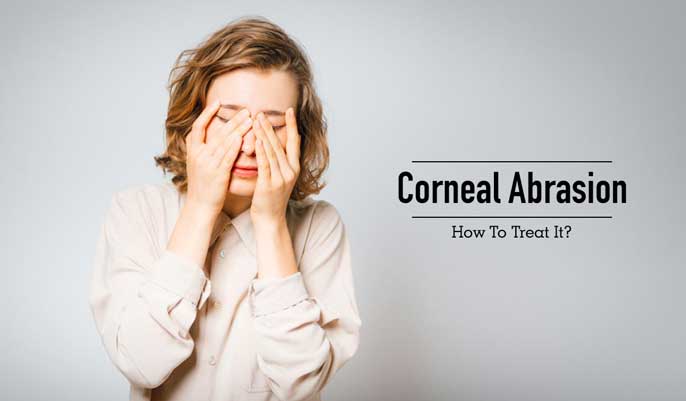
Prima Medical Center Saigon, Eye Diseases
Corneal Abrasion: How to Treat a Scratched Eye
8 December, 2023

A corneal abrasion (scratched cornea or scratched eye) is one of the most common eye injuries.
A corneal abrasion (scratched cornea or scratched eye) is one of the most common eye injuries.
The cornea is the clear front surface of the eye. A corneal abrasion disrupts the protective outer layer of cells of the cornea (called the corneal epithelium). It creates an open wound that increases your risk of a serious eye infection. So, it’s important to see an eye doctor immediately if you suspect you have a corneal abrasion.
What causes a corneal abrasion?
There are countless ways to get a corneal abrasion. No matter how big or small, anything that makes contact with the surface of your eye can cause a scratched cornea.
Tree branches, paper, makeup brushes, a pet, a finger, workplace debris, sports equipment and more all are common causes of a corneal abrasion.
Many corneal abrasions aren’t caused by a major traumatic event, such as getting poked in the eye. Sand, dust and other small particles can cause a corneal abrasion as well, especially if you rub your eyes.
Dry eyes can increase your risk of a corneal abrasion, particularly if you routinely wake up with dry eyes. If your eyes dry out while you are sleeping, your eyelids may stick to your cornea. When you wake up and open your eyes, your eyelids can tear part of the corneal epithelium, causing a painful abrasion.
Contact lenses usually won’t protect your eyes from corneal abrasions. In fact, if your contacts are damaged or you wear them too long, they may even increase your risk of a scratched cornea.
Symptoms of A Corneal Abrasion
A scratched cornea often causes significant discomfort, red eyes and hypersensitivity to light.
The cornea is one of the most sensitive parts of your body. Even a very small corneal abrasion can be extremely painful and feel much larger in size — as if you have a big, rough object in your eye.
In addition to pain and a gritty or foreign body sensation. Other signs and symptoms of corneal abrasions include redness, tearing, light sensitivity, headache, blurry or decreased vision, eye twitching, a dull ache and, occasionally, nausea.
If you think you may have suffered a corneal abrasion and are experiencing any of these symptoms, see an eye doctor near you right away.
What to expect from a scratched cornea
People have a tendency to rub their eyes when they feel like something is “in” them. This can make matters much worse. If you get something in your eye, you can attempt to flush it out with water. Don’t rub your eye. Don’t patch it either, since this can speed bacterial growth and increase the risk of an eye infection.
If possible, rinse your eye with a sterile saline eye wash or a multipurpose contact lens solution. Don’t tap water or bottled water. Microorganisms such as Acanthamoeba have been found in tap water and even bottled water, and these pathogens can cause a serious, vision-threatening infection if introduced to an eye with a scratched cornea.
After flushing the eye, if redness, pain or foreign body sensation continues, seek immediate attention because corneal abrasions can cause serious harm within hours.
To diagnose a corneal abrasion, your optometrist or ophthalmologist may apply an eye drop to numb your eye so you can keep it open for the exam. Another type of eye drop may be used to help your doctor see the extent of the abrasion when viewing your eye with a blue light and an examining microscope called a slit lamp.
Depending on what may have caused the scratch and what doctors @ Prima Medical Center Saigon sees during the exam, your eye might be gently swabbed for a culture to ensure proper treatment in the event of infection..
Prima Saigon is one of the prestigious eye hospitals in Vietnam, recognized by the US embassy in Vietnam.
If you need an eye assessment, please have a visit to Prima Medical Center Saigon
- Address: 27 Ky Dong St, District 3, HCMC
- Website: https://primahealth.vn/en/
- Business Hours: 07:30 – 17:00 from Monday – Saturday
- HOTLINE: 0919-209-039 or 1900 – 9115
Prima Saigon recommends that clients should reserve their intended consultation at least three days before their visit for convenience and less waiting time.

A corneal abrasion (scratched cornea or scratched eye) is one of the most common eye injuries.
A corneal abrasion (scratched cornea or scratched eye) is one of the most common eye injuries.
The cornea is the clear front surface of the eye. A corneal abrasion disrupts the protective outer layer of cells of the cornea (called the corneal epithelium). It creates an open wound that increases your risk of a serious eye infection. So, it’s important to see an eye doctor immediately if you suspect you have a corneal abrasion.
What causes a corneal abrasion?
There are countless ways to get a corneal abrasion. No matter how big or small, anything that makes contact with the surface of your eye can cause a scratched cornea.
Tree branches, paper, makeup brushes, a pet, a finger, workplace debris, sports equipment and more all are common causes of a corneal abrasion.
Many corneal abrasions aren’t caused by a major traumatic event, such as getting poked in the eye. Sand, dust and other small particles can cause a corneal abrasion as well, especially if you rub your eyes.
Dry eyes can increase your risk of a corneal abrasion, particularly if you routinely wake up with dry eyes. If your eyes dry out while you are sleeping, your eyelids may stick to your cornea. When you wake up and open your eyes, your eyelids can tear part of the corneal epithelium, causing a painful abrasion.
Contact lenses usually won’t protect your eyes from corneal abrasions. In fact, if your contacts are damaged or you wear them too long, they may even increase your risk of a scratched cornea.
Symptoms of A Corneal Abrasion
A scratched cornea often causes significant discomfort, red eyes and hypersensitivity to light.
The cornea is one of the most sensitive parts of your body. Even a very small corneal abrasion can be extremely painful and feel much larger in size — as if you have a big, rough object in your eye.
In addition to pain and a gritty or foreign body sensation. Other signs and symptoms of corneal abrasions include redness, tearing, light sensitivity, headache, blurry or decreased vision, eye twitching, a dull ache and, occasionally, nausea.
If you think you may have suffered a corneal abrasion and are experiencing any of these symptoms, see an eye doctor near you right away.
What to expect from a scratched cornea
People have a tendency to rub their eyes when they feel like something is “in” them. This can make matters much worse. If you get something in your eye, you can attempt to flush it out with water. Don’t rub your eye. Don’t patch it either, since this can speed bacterial growth and increase the risk of an eye infection.
If possible, rinse your eye with a sterile saline eye wash or a multipurpose contact lens solution. Don’t tap water or bottled water. Microorganisms such as Acanthamoeba have been found in tap water and even bottled water, and these pathogens can cause a serious, vision-threatening infection if introduced to an eye with a scratched cornea.
After flushing the eye, if redness, pain or foreign body sensation continues, seek immediate attention because corneal abrasions can cause serious harm within hours.
To diagnose a corneal abrasion, your optometrist or ophthalmologist may apply an eye drop to numb your eye so you can keep it open for the exam. Another type of eye drop may be used to help your doctor see the extent of the abrasion when viewing your eye with a blue light and an examining microscope called a slit lamp.
Depending on what may have caused the scratch and what doctors @ Prima Medical Center Saigon sees during the exam, your eye might be gently swabbed for a culture to ensure proper treatment in the event of infection..
Prima Saigon is one of the prestigious eye hospitals in Vietnam, recognized by the US embassy in Vietnam.
If you need an eye assessment, please have a visit to Prima Medical Center Saigon
- Address: 27 Ky Dong St, District 3, HCMC
- Website: https://primahealth.vn/en/
- Business Hours: 07:30 – 17:00 from Monday – Saturday
- HOTLINE: 0919-209-039 or 1900 – 9115
Prima Saigon recommends that clients should reserve their intended consultation at least three days before their visit for convenience and less waiting time.



